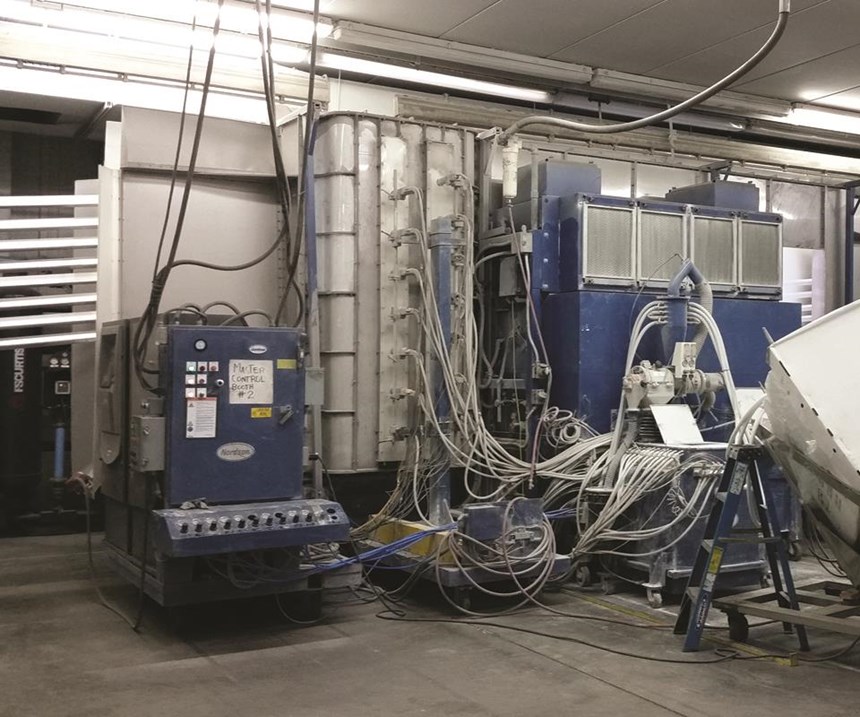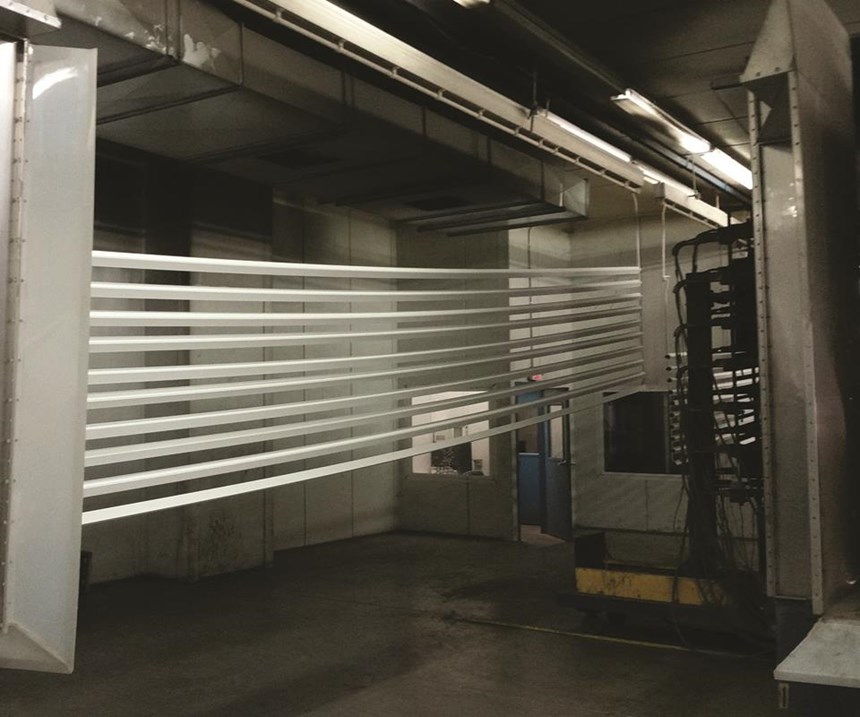Sunny Outlook for Florida Powder Coater
Benada Aluminum rebounds their business with improved chemistries and equipment in their powder coating operations.
#curing #masking
Business is very sunny for Benada Aluminum Products in Sanford, Florida. This is a good thing, since the company’s profitability relies on people getting out and enjoying time at the pool or opening new windows in their homes.
The full-service aluminum extruder sells products to some of the top window makers, patio equipment manufacturers and home accessory suppliers in the U.S., and it has done so for the past 60 years.
Featured Content
Part of the Benada process includes a massive horizontal powder coating line capable of coating extrusions as large as a whopping 40 feet in length. On any given day, the line can coat more than 130,000 pounds of extrusions, with the ability to expand production if required.
That is especially important every spring, when homeowners all along Florida’s warm coastline and other parts of the country begin opening their pools and decide they need a new screened porch or chairs and furniture for their patios.
“We work on all kinds of patio products, whether they be screen enclosures or the patio rooms,” Sales Manager Tom Marki says. “The warmer weather hits and we are busy night and day.”
Patio Furniture, Enclosure Market
“About 60 percent of our work is mainly for the patio furniture and enclosure market, and the rest is windows and other products,” James Keller says, a master scheduler who helps keep the large extruding facility in sync with the powder coating plant on the same grounds.
The products that Benada makes every day come in all shapes and sizes, and include bars and rods, square and rectangular tubes, angles, channels, pipes and dots, round tubes, pool and patio profiles, screen door shapes, fencing profiles, awnings, shutters, hurricane protection, patio furniture, windows, doors, storefront shapes, walkways and bleachers, among others.
Benada is an Axalta-certified powder coater and also has certifications for AAMA 2603 standard colors, AAMA 2604 architectural finishes and AAMA 2605 high-performance coatings.
It offers two standard paint colors—white and bronze—but also has a library of about 25 custom colors, and Marki says the company can match any color requested by customers. Its high quality coatings come with warranties of five years for the 2603 paints and 10 years for the 2604 paints.
“A great majority of our work goes straight to the distributors,” Marki says. “The public doesn’t know us, but all the major distributors know us well.”
Benada had a rough time in 2012, during which it had to file for Chapter 11 bankruptcy protection, but the company says it has rebounded well, thanks to leadership from President Jim Piperato, Vice President Kim Dahl Marki, who runs the sales operation, and Keller, who keeps everything on track from a production standpoint.
Its customers have noticed the improvement.
“We have had a long-standing relationship with this facility, and even though there have been some tough times, the team has always taken care of the issues,” says Frank Patierno of Lansing Building Products. “We are extremely excited with both the new management and sales teams that have been assembled.”
Lynda McClure of Patio Products Manufacturing says her company has been purchasing extrusions from Benada for more than 10 years.
“After a lot of hard work and changes, they have grown to be a strong, reliable source that we depend on,” she says. “They are truly customer-service-driven.”
Direct, Indirect Extrusion Process
Before any product gets to the large coating facility within the plant, it starts out as a billet of aluminum across the parking lot, where engineers and workers design how the material will be extruded into the final shapes.
The billets come in widths of 6 or 8 inches, are softened by heat prior to extrusion and then placed in to a powerful hydraulic press where a ram pushes a dummy block that forces the softened metal through a precision opening—also known as a die—to produce the shape the customer wants.
Benada has both direct and indirect extrusion processes. The more common direct process involves the ram shoving the billet through the extrusion. Indirect extrusion is similar, but with several important differences. In the indirect process, the die is contained within the hollow ram that moves into the stationary billet from one end, forcing the metal to flow into the ram, and thereby acquiring the shape of the die as it does so.
The aluminum billets are usually composed of alloys containing small amounts (usually less than 5 percent) of copper, manganese, silicon, magnesium or zinc. The billet is softened in a heating furnace (the melting point of aluminum varies with the purity of the metal but is about 1,220°F/660°C). The extrusion process usually takes place with the billet heated to just over 700°F/375°C.
The ram applies pressure to the billet with between 100 and 15,000 tons of pressure, depending on how large an extrusion is needed. The billet is crushed against the die until it has no place else to go, and it begins to squeeze out through the die to emerge on the other side as a fully formed profile.
Some presses extrude slowly, at one or two feet per minute; a softer alloy taking on a very simple shape may be extruded at a rate of 180 feet per minute or even faster. The hot extrusion is then quenched, mechanically treated and aged to ensure sufficient metallurgical properties before it is moved to Benada’s coating facility next door.
“The aging process ensures the uniform precipitation of fine particles through the metal,” Keller says. “It yields maximum strength, hardness and elasticity for the specific extrusion alloy.”
Data-Driven Pretreatment System
The coating system includes a three-stage pretreatment system that starts with a cleaner, a reverse osmosis rinse and an adhesion promoter composed of chemicals supplied by Bulk Chemicals (BCI). The parts are then hung and coated with an Axalta line of powder coatings.
Keller ran the Benada coating line for almost five years before moving to the master scheduling department, but he says his heart remains in extrusion coating. It is an area that receives a lot of attention from company officials because of warranty and quality issues.
For example, each hour, an experienced staff member tests the adhesion and curing of the coated extrusions, allowing Benada and the coating team to respond quickly if a problem is discovered so that necessary adjustments can be made.
“A lot of companies wouldn’t test every hour, but it was a decision we made a long time ago, and we do it religiously,” Keller says. “We stepped up our quality control measures because it is important to us. We look at our cleaning and our tanks, and we take it very seriously, because our customers depend on it from us.”
The quality control includes the hourly tests as well as hourly titration checks of chemicals. Benada’s process got a boost when it partnered with BCI to install a computerized process control system to help the company maintain quality in its pretreatment tanks.
BCI’s wet section process-control equipment is teamed with its data acquisition system, BDACS, to provide customers with a human-machine interface capable of processing data acquisition while providing a user-friendly reconfigurable graphical interface.
The BDACS single-stage chemical process controllers or multi-stage chemical process-control systems are capable of real-time process control and monitoring; data trending and performance tracking; process conditions using the parts-tracking module; alarm notifications; realtime and archived data analytical tools; and custom reports based on jobs run, among other features.
“We have installed over 40 systems in a variety of disciplines, including extrusion lines, coil lines and parts washers,” Sergio Mancini says, director of sales at the Reading, Pennsylvania, company. “Our remote control features and our integration of business systems with process data is a sought-after module.”
Keller says the acquisition system has made fine-tuning the pretreatment process a much simpler endeavor. “Everything is more leveled out because it is maintained by the controllers,” he says. “It feeds the system with chemicals when it needs to, and it’s all based on conductivity.”
While Keller says the system is set up to reduce human error on the front end, there is also a stepped up effort for quality control testing on the back end when the parts are powder-coated.
He says that the testing is not a requirement from Benada customers, but that it is a way to make sure a product leaves the plant exactly as it was ordered.
“We put the data on paper after we perform the testing on the finish,” Keller says. “If need be, we can trace the order number to our quality control reference if there is an issue.”
Quick Color Changes
About three years ago, Benada upgraded to a Nordson ColorMax quick color change powder spray system, which cut its change time of four to six hours to as little as 15 minutes, a huge improvement that Keller says has helped every part of the facility’s operation.
“The biggest improvement overall has been in lead times,” he says. “When we started offering more colors, we had to go way out on lead times, but now we can get those times down to a fraction of what they were. We used to prep a day in advance if we needed to change colors, but now we can do up to six color changes in a day and not feel a delay.”
Marki says the newer powder coating equipment and advanced chemistry system have been extremely helpful in filling orders for customers, especially with a surge in seasonal demands, such as with patio furniture, windows and enclosed pools.
Keller has a unique way to describe Benada’s super-charged, super-long powder coating line.
“The line is an animal,” he says. “We’ve coated as many as 130,000 pounds of material in one day, and even then, we didn’t come close to the capacity that we have on those coating lines. We have a lot of room still.”
For more information, visit benada.com, axaltacs.com, nordson.com, bulkchemicals.us.
Originally published in the February 2017 article.
RELATED CONTENT
-
Anodizing Vs. Powder Coat
I am an engineer on a large yacht build project and urgently need information and advice on choosing a finish for the aluminum deck plates in the engine room.
-
The Powder Coating Process
Powder coating is one of the most durable finishes that can be applied to industrial manufactured products, and offers excellent corrosion protection and is very safe because of its lack of volatile organic compounds. To understand the powder coating process you should start with the fundamentals.
-
Coating Systems with the Best Long-Term Performance
The best protection against corrosion and UV exposure, says Axalta’s Mike Withers, is electrocoat and a super durable powder coating.























